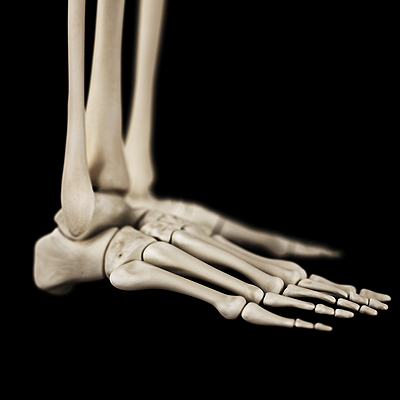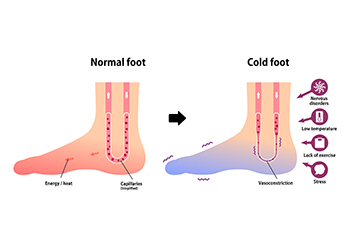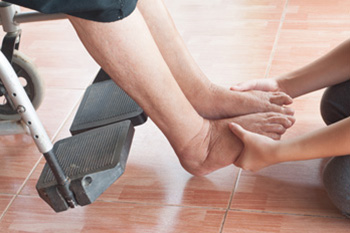Items filtered by date: September 2023
Causes and Treatment of Foot Stress Fractures

Stress fractures in the feet are a common injury among athletes and individuals engaged in high impact activities. These hairline fractures result from repetitive stress and overuse, typically occurring in weight-bearing bones like the metatarsals. One primary cause is a sudden increase in physical activity. This can include increasing training intensity or mileage too quickly. Insufficient rest between workouts can also contribute to the development of stress fractures. Biomechanical factors consisting of poor foot arch support or gait abnormalities, can place excessive stress on specific bones, further increasing the risk. Treatment for stress fractures primarily involves rest, which allows the bone to heal. Immobilization with a cast or walking boot may be necessary, and in some cases, weight-bearing restrictions may apply. Pain management, correcting running form, or using orthotics, may be essential for a full recovery. Early diagnosis and prompt treatment are important in preventing further damage and complications. If you have endured a foot stress fracture, it is strongly suggested that you are under the care of a chiropodist who can diagnose and offer you correct treatment options.
A stress fracture often requires medical attention as it can progress and worsen over time. Please consult with Emily Yu, B.Sc from Uptown Foot Care Clinic. Our specialist will assess your condition and provide you with quality foot and ankle treatment.
A stress fracture refers to a fine crack in a bone. This type of fracture is especially common in the feet, as they often endure repetitive pressure from daily activities such as walking or running. Stress fractures occur when the affected bone can not support the load being placed on it. Stress fractures in the foot can occur in any bone, but often affect the metatarsal bones which connect the toes to the rest of the foot, the heel bone, or the navicular bone on the top of the foot.
Symptoms
Symptoms of a stress fracture may include:
Deep, dull pain
Sharp, localized pain
Intermittent pain
Tenderness
Weakness
Swelling
Bruising
Changes in the biomechanics of the foot
Diagnosis
Stress fractures in the foot are diagnosed via medical history and a physical exam. You may also need to have diagnostic imaging tests like X-rays, MRIs, CT scans, bone scans, or an ultrasound performed to confirm the diagnosis and to rule out any other problems.
Treatment
Nonsurgical treatment options include resting, icing, compressing and elevating the affected foot, taking nonsteroidal anti-inflammatory pain medications, modifying your footwear, wearing a cast, and using crutches. Certain types of foot fractures, such as navicular fractures, respond poorly to nonsurgical treatment and may need surgery to fully heal.
If you have any questions, please feel free to contact our office located in . We offer the newest diagnostic and treatment technologies for all your foot care needs.
Preparing Your Feet for the Cold Season

As the temperature drops and winter approaches, it is time to give your feet some extra care and attention to ensure they remain healthy and comfortable during the chilly months. Cold weather can be harsh on your feet, often leading to issues consisting of dryness, cracking, and even frostbite if not adequately protected. To prepare your feet for winter, start by keeping them clean and well moisturized. Invest in a good quality foot cream, and apply it daily to prevent dryness and cracking. Wear warm, moisture wicking socks to keep your feet cozy and dry, and opt for insulated, waterproof boots when braving the winter elements. Trim your toenails straight across to prevent ingrown toenails. Additionally, it is beneficial to stay hydrated and good circulation can be maintained by staying active. By following these simple steps, you can ensure your feet stay happy and healthy throughout the winter season. If you would like more information about winter foot care, it is suggested that you confer with a chiropodist who can provide you with the knowledge you are seeking.
The winter months can bring about new or worsening foot and ankle problems. If you’re suffering from foot or ankle pain, please consult with Emily Yu, B.Sc from Uptown Foot Care Clinic. Our specialist can help you maintain the health of your lower limbs and your mobility.
Winter Foot Problems
Cracked heels - Dry, cracked skin on the heels of the feet that is associated with cold, dry weather
Athlete’s foot - A fungal infection on the skin of the feet
Blisters - Fluid-filled bubbles of skin that usually form in response to friction
Fractures - Broken bones in the feet or ankles
Metatarsalgia - General foot pain
Chilblains - Spasming of the small blood vessels in the toes in response to exposure to cold weather
Raynaud’s disease - Numbness, pain, and color changes in the toes due to cold weather
Prevention
Wear warm socks and shoes
Avoid prolonged exposure to the cold
Moisturize the heels regularly
Keep your feet clean and dry
Walk carefully in areas that may be icy
Wear non-slip shoes
If you have any questions, please feel free to contact our office located in . We offer the newest diagnostic and treatment technologies for all your foot care needs.
Raynaud’s Phenomenon and the Feet

Raynaud's phenomenon, also known as Raynaud's disease, is a condition where the toes become cold and numb in response to cold temperatures or stress. This occurs due to blood vessels spasming and narrowing, reducing blood supply. When blood flow returns, the affected areas flush red. Raynaud’s disease is relatively rare, with a higher prevalence among females. Treatment focuses on symptom management. For mild cases, keeping the extremities warm and soaking them in warm water during an attack can be helpful. In more severe cases, medications may be prescribed, and vasodilators may be used to improve blood flow. Preventative measures include maintaining warmth, managing stress, and exercising regularly. Additionally, limiting caffeine and alcohol, refraining from smoking, and avoiding stress triggers may help to prevent this condition. Raynaud's disease can be primary, without an underlying condition, or secondary and linked to other medical issues such as autoimmune diseases or repetitive movements. Diagnosis involves a thorough medical evaluation, including blood tests. If left untreated, severe complications can arise. If you have these symptoms, it is suggested that you make an appointment with a chiropodist for a proper diagnosis and treatment.
Systemic diseases are medical problems that affect the entire body. Many systemic diseases can bring about foot and ankle problems. If you have a systemic disease that affects your lower limbs, please consult with Emily Yu, B.Sc from Uptown Foot Care Clinic. Our specialist can help you maintain the health of your lower limbs and your mobility.
Which systemic diseases can affect the feet?
Peripheral artery disease - Causes inadequate blood flow to the lower limbs
Peripheral neuropathy - Nerve damage in the nerves that supply the feet and ankles
Diabetes - Can cause nerve damage, poor circulation, and a weakened immune system that can lead to the formation of poorly healing wounds on the feet
Arthritis - A disease of the joints that damages joint lining, it often affects the small joints of the feet and the ankle joints
Gout - A build up of uric acid in the bloodstream that forms crystals that can lodge in the joints
How can a chiropodist help?
Chiropodists help people who have systemic disease manage and maintain their foot health in a variety of ways. They can diagnose a multitude of foot and ankle problems, screen for certain systemic conditions, teach patients about proper foot care, and provide information about preventive strategies that patients could employ to avoid complications from their systemic diseases. Chiropodists can also treat foot and ankle problems through medications, foot and ankle exercises, orthotics, and lifestyle recommendations, among many other potential treatments
If you are living with a systemic illness that impacts your foot health, please feel free to contact our office located in . We offer the newest diagnostic and treatment technologies for all your foot care needs.
Navigating the Complexity of Aging Feet

The human foot is a marvel of engineering complexity. Not only do our feet support our weight, but they also serve as shock absorbers and provide crucial feedback to our brains for balance. Given their multifaceted role, it is no surprise that foot problems can arise, especially as we grow older, often impacting overall health and mobility. As we age, our feet undergo changes. The fatty cushion thins, arches flatten, and toenails can become brittle. Foot shape often evolves, sometimes necessitating a change in shoe size. Health conditions such as osteoporosis, obesity, arthritis, and diabetes can exacerbate these changes. Some common foot issues seniors face are bunions, hammertoes, and corns. Infections, ingrown toenails, and arthritis are also common foot ailments among elderly people. Diabetic foot problems can be particularly severe due to nerve damage. Additionally, moisturizing the the feet to prevent cracks and calluses, trimming toenails straight across, and wearing properly fitted shoes are important to maintain healthy feet. With elderly challenges, such as vision loss, reduced flexibility, or dementia, it can be especially daunting to maintain foot health. If you are a senior or taking care of one, it is strongly suggested that you make an appointment with a chiropodist for routine examinations.
Foot problems can become increasingly common as we age, making everyday foot care especially important. To learn more about maintaining proper foot health, please consult with Emily Yu, B.Sc from Uptown Foot Care Clinic. Our specialist will assess your condition and provide you with quality foot and ankle treatment.
Common Foot Problems
Certain foot problems may be more likely to affect older adults.
Some examples of foot conditions that can be common in older adults include:
Dry, cracked skin
Calluses and corns
Blisters
Ingrown toenails
Deformities such as bunions or hammertoes
Fungal infections
Plantar warts
Systemic conditions, such as diabetes or arthritis, are also more likely to affect older people and manifest symptoms in the feet and ankles.
Daily Foot Care Tips
Having a daily foot care routine can help detect problems early on and prevent future issues.
Things that you can do at home to care for your feet include:
Washing the feet daily with warm water, drying them thoroughly, and then applying a moisturizer
Trimming the toenails straight across and not too short to prevent ingrown toenails
Performing daily foot exercises to improve foot strength and mobility
Wearing shoes when walking to avoid injury
Inspecting the feet daily for any cuts, scrapes, sores, or other abnormalities and seeking prompt treatment if any problems are discovered
If you have any questions, please feel free to contact our office located in . We offer the newest diagnostic and treatment technologies for all your foot care needs.
